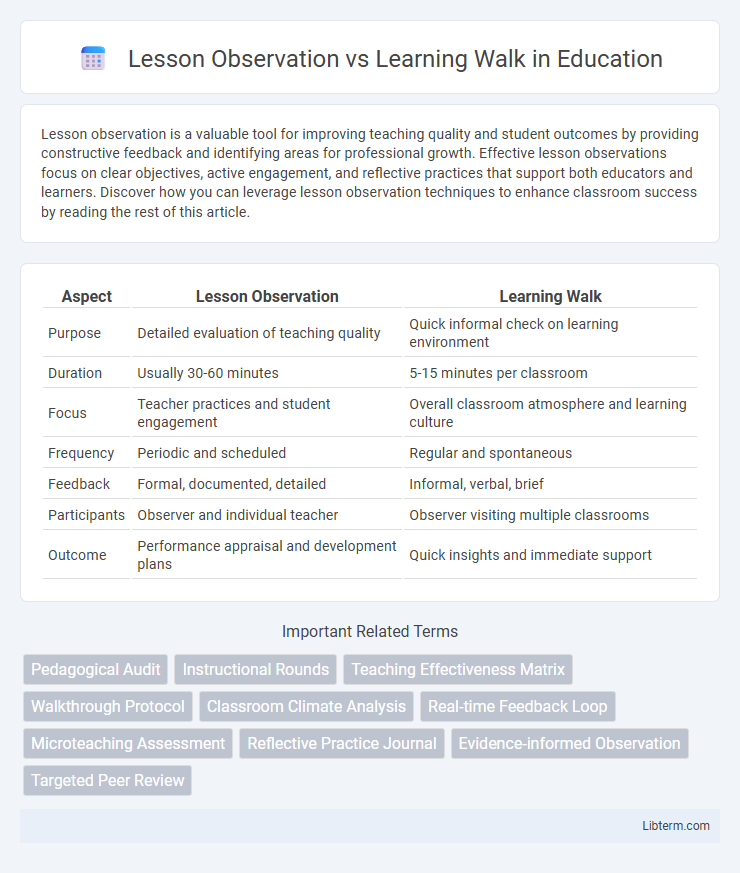Lesson observation is a valuable tool for improving teaching quality and student outcomes by providing constructive feedback and identifying areas for professional growth. Effective lesson observations focus on clear objectives, active engagement, and reflective practices that support both educators and learners. Discover how you can leverage lesson observation techniques to enhance classroom success by reading the rest of this article.
Table of Comparison
| Aspect | Lesson Observation | Learning Walk |
|---|---|---|
| Purpose | Detailed evaluation of teaching quality | Quick informal check on learning environment |
| Duration | Usually 30-60 minutes | 5-15 minutes per classroom |
| Focus | Teacher practices and student engagement | Overall classroom atmosphere and learning culture |
| Frequency | Periodic and scheduled | Regular and spontaneous |
| Feedback | Formal, documented, detailed | Informal, verbal, brief |
| Participants | Observer and individual teacher | Observer visiting multiple classrooms |
| Outcome | Performance appraisal and development plans | Quick insights and immediate support |
Introduction to Lesson Observation and Learning Walk
Lesson observation involves a structured process where educators' teaching practices are closely reviewed to assess instructional effectiveness and student engagement. Learning walks are informal, brief visits by school leaders or peers aimed at gathering insights on classroom environments and learning processes without formal evaluation. Both methods contribute uniquely to professional development and school improvement by offering distinct perspectives on teaching and learning.
Defining Lesson Observation
Lesson observation involves a structured process where an educator's teaching practice is systematically monitored and evaluated to enhance instructional quality. It provides targeted feedback based on specific pedagogical criteria, emphasizing lesson delivery, student engagement, and learning outcomes. This method serves as a critical tool for professional development through direct insight into classroom dynamics.
Defining Learning Walk
A Learning Walk is a structured, informal classroom visit designed to gather insights about teaching practices and student engagement without formal evaluation. It focuses on identifying trends, sharing best practices, and promoting collaborative professional development among educators. Unlike traditional Lesson Observations, Learning Walks prioritize reflection and continuous improvement over assessment or judgment.
Key Objectives: Observation vs. Walk
Lesson Observation emphasizes detailed evaluation of teaching methods, student engagement, and curriculum delivery to provide targeted feedback for professional development. Learning Walks focus on quick, informal visits to multiple classrooms to gauge overall learning environment, assess teacher collaboration, and identify school-wide trends. Both aim to improve educational outcomes but differ in scope, depth, and frequency of classroom interactions.
Process and Methodology: A Comparative Analysis
Lesson observation involves a structured process where an observer evaluates a teacher's instructional delivery against predefined criteria, emphasizing specific pedagogical techniques and student engagement. Learning walk methodology is more informal and collaborative, encouraging multiple educators to gather qualitative insights through brief, focused visits across different classrooms to identify patterns and promote shared professional development. Comparing these methods highlights that lesson observations are typically evaluative and data-driven, while learning walks prioritize reflective dialogue and continuous improvement within educational communities.
Teacher Involvement and Feedback
Lesson observation centers on detailed teacher involvement where educators actively demonstrate instructional strategies while receiving specific, structured feedback aimed at improving lesson delivery. Learning walks involve brief, informal visits to multiple classrooms, allowing teachers to observe diverse practices and gather immediate, peer-based feedback without formal evaluations. Both methods emphasize reflective teacher participation but differ in depth and feedback style, influencing professional growth and instructional refinement.
Impact on Teaching and Learning
Lesson observations provide detailed, focused feedback on teaching practices, enabling targeted improvements in instructional strategies and student engagement. Learning walks offer a broader overview of classroom environments and school culture, identifying patterns that influence overall teaching effectiveness and learning outcomes. Both methods contribute to professional development, but lesson observations have a more direct impact on refining individual teaching skills, while learning walks inform systemic improvements.
Advantages and Limitations of Lesson Observation
Lesson observation provides detailed insights into teaching methods and student engagement, allowing for targeted feedback and professional development. However, it can be time-consuming, potentially intrusive, and may cause teacher anxiety, which can impact the authenticity of lessons observed. Unlike learning walks that offer broader, informal snapshots of classroom dynamics, lesson observations require more structured evaluation, limiting their flexibility and frequency.
Pros and Cons of Learning Walks
Learning Walks offer real-time insights into classroom dynamics, allowing leaders to identify teaching practices and student engagement effectively. The informal nature of Learning Walks promotes open communication but may lack comprehensive evaluation compared to formal Lesson Observations. However, their brief and frequent visits can miss deeper instructional issues, requiring complementary assessment methods for a full understanding of learning effectiveness.
Choosing the Right Approach for School Improvement
Lesson observation provides detailed insights into individual teaching practices by allowing evaluators to assess specific instructional techniques and student interactions. Learning walks offer a broader perspective by enabling school leaders to identify patterns and trends across multiple classrooms, promoting collaborative professional development. Selecting the right approach depends on the school's improvement goals, with lesson observations suited for targeted teacher feedback and learning walks aligning with systemic culture change and ongoing monitoring.
Lesson Observation Infographic

 libterm.com
libterm.com